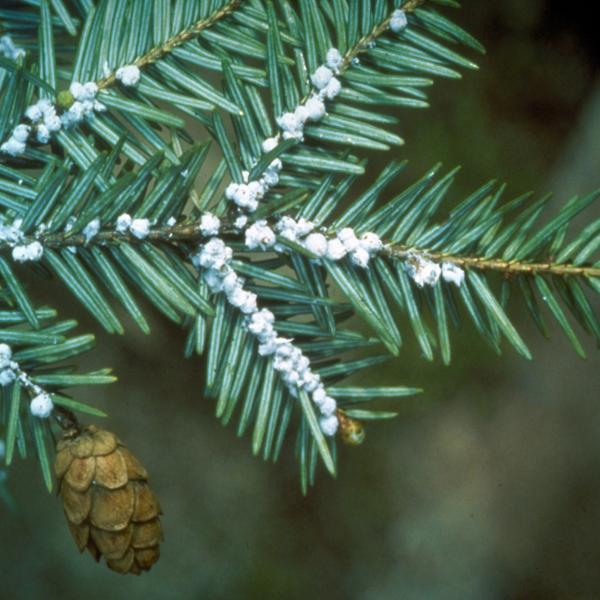
The long cold winter of 2014-2015 will go in the record books for a number of reasons. It certainly impacted Vermont’s hemlock woolly adelgid survey program. Hemlock woolly adelgid (hwa) is an invasive insect from Asia that feeds on hemlock trees. It has been known to be in southern Vermont since 2007; primarily in Windham County, with small isolated infestations in Windsor and Bennington Counties.
From the beginning volunteers have been an important component of the hwa detection program. This year’s winter weather has delayed some of the work, but surveys are being done. As many as 23 volunteers braved the cold and contributed at least 90 hours to look for adelgid. Surveys have been conducted in 14 towns so far. There is still a need for some work to be done in Wilmington, Dover and Woodford. Surveys can still be done. One or two people can do a survey site in an hour or two. Training is available, just contact Jim Esden – jim.esden@state.vt.us or 802-777-1591.
The long duration cold of this winter had a severe impact on the hwa population. Four sites are monitored annually to determine the winter mortality rate. This year the rate ranged from 97 to 99 percent. This is the second winter in a row to have such high mortality. One result has been no observed spread of the infestation. While surveys done in areas known to be infested have sometimes been positive for hwa, there have been no new towns discovered.
That we are seeing as many hwa as we are – remember last year also had very high mortality rates – reminds us that hwa is an invasive partially because of its high reproductive rate. Hemlock woolly adelgid has two generations each year. All the adelgids are females who lay eggs that don’t need to be fertilized. If even one adelgid survives, she can perpetuate the infestation. Trees will experience a lower level of feeding and damage and so, have a reprieve, but the danger has not gone away.
The Department of Forests, Parks and Recreation has begun a monitoring program to try to track the recovery of the next generation of hwa. Samples were tagged and counted in Jamaica State Park with the help of students from Burr and Burton Academy’s Mountain Campus on March 25. These branches will be reexamined in June. Three other sites are slated for similar monitoring. The results will help to have an idea of how the hwa population rebounds. The data is also shared with the Hemlock Woolly Adelgid Initiative, a multi- state group cooperating on hwa management.
At this time of year, surviving hwa will be laying eggs. The winter generation can lay up to 300 eggs per adult. Eggs are found under the fluffy white ovisac and can be seen with a hand lens. They are ovoid and become an orange color. Common wisdom and anecdotal evidence suggest t some hwa may survive very low temperatures if they happen to be attached to branches that become covered by snow. Protected by insulating snow, these adelgids may not be exposed to lethal temperatures and survive to continue the infestation. If you happen to find hwa and especially with eggs, Jim Esden would be interested to know.
By Jim Esden, Forester, VT Department of Forests, Parks and Recreation
Photo Credit: Connecticut Agricultural Experiment Station Archive, Connecticut Agricultural Experiment Station, Bugwood.org